WBR0570: Difference between revisions
Jump to navigation
Jump to search
YazanDaaboul (talk | contribs) No edit summary |
YazanDaaboul (talk | contribs) No edit summary |
||
| Line 21: | Line 21: | ||
|MainCategory=Pathophysiology | |MainCategory=Pathophysiology | ||
|SubCategory=Neurology | |SubCategory=Neurology | ||
|Prompt=A previously healthy 14-year-old boy is brought by his mother for muscle weakness | |Prompt=A previously healthy 14-year-old boy is brought by his mother for a two-day history of muscle weakness in the lower extremities. The mother reports that her child had a prodrome of fever, headaches, and vomiting for a few days. The mother informs the physician that the family has recently emigrated from Nigeria less than a month ago. Neurological examination reveals muscle weakness in the lower extremities more pronounced on the right side, absent reflexes in the legs bilaterally and muscle fasciculations in both femoral regions. Sensory neurological exam is unremarkable in the upper and lower extremities. A lumbar puncture is performed, and CSF profile demonstrates leukocytosis. A neurological lesion in the spinal cord is suspected. Which of the following spinal cord images (lesions depicted in red) represents the site of the neurological lesion in this child? | ||
|Explanation=Poliomyelitis is caused by | |Explanation=Poliomyelitis is caused by poliovirus, an enterovirus that peaked in the 1950s before it was almost eradicated following the introduction of the killed IPV (Salk) and the attenuated OPV (Sabin) vaccines. Poliomyelitis may result in paralytic symptoms, which may be classified as bulbar, spinal, or bulbospinal, the most common of which is the spinal paralytic poliomyelitis. Poliomyelitis may have an asymptomatic course or non-specific symptoms that may be followed by acute asymmetric flaccid paralysis of the lower extremities with areflexia within a few days of symptoms onset. Poliovirus is transmitted by the fecal-hand-oral route and replicated in the oropharynx, the intestinal mucosa, and then in the submucosal lymphatic tissue before it invades the CNS. The involvement of the spinal cord is usually at the level of the anterior horns leading to lower motor neuron symptoms.The child is presenting for acute muscle weakness following a prodrome of [[fever]], [[headache]], and vomiting. The findings of asymmetric flaccid paralysis, muscle [[fasciculation]], absence of sensory involvement, and areflexia in the lower extremities are consistent with lower motor neuron (LMN) involvement that suggest poliomyelitis. Given the history, physical examination findings, and the CSF leukocytosis, the diagnosis of poliomyelitis is likely. | ||
|AnswerA=[[Image:WBR0570A.gif|450px]] | |AnswerA=[[Image:WBR0570A.gif|450px]] | ||
|AnswerAExp=This image illustrates a lesion in the central cord depicting [[syringomyelia]]. Poliomyelitis is not associated with lesions in the central cord. | |AnswerAExp=This image illustrates a lesion in the central cord depicting [[syringomyelia]]. Poliomyelitis is not associated with lesions in the central cord. | ||
|AnswerB=[[Image:WBR0570B.gif|450px]] | |AnswerB=[[Image:WBR0570B.gif|450px]] | ||
|AnswerBExp=This image illustrates asymmetric lesions in the white matter characteristic of [[multiple sclerosis]] | |AnswerBExp=This image illustrates asymmetric lesions in the white matter characteristic of [[multiple sclerosis]]. | ||
|AnswerC=[[Image:WBR0570C.gif|450px]] | |AnswerC=[[Image:WBR0570C.gif|450px]] | ||
|AnswerCExp=This image illustrates lesions in the dorsal columns consistent with | |AnswerCExp=This image illustrates lesions in the dorsal columns consistent with tertiary syphilis. | ||
|AnswerD=[[Image:WBR0570D.gif|450px]] | |AnswerD=[[Image:WBR0570D.gif|450px]] | ||
|AnswerDExp=This image illustrates lesions in the anterior horn of the [[spinal cord]] | |AnswerDExp=This image illustrates lesions in the anterior horn of the [[spinal cord]] characteristic of [[poliomyelitis]]. | ||
|AnswerE=[[Image:WBR0570E.gif|450px]] | |AnswerE=[[Image:WBR0570E.gif|450px]] | ||
|AnswerEExp=This image illustrates lesions in the white matter and grey matter. This pattern of lesions is found in amyotrophic lateral sclerosis ([[ALS]]), which presents signs and symptoms of both upper and lower motor neuron disease. | |AnswerEExp=This image illustrates lesions in the white matter and grey matter. This pattern of lesions is found in amyotrophic lateral sclerosis ([[ALS]]), which presents signs and symptoms of both upper and lower motor neuron disease. | ||
Revision as of 22:42, 14 October 2014
| Author | [[PageAuthor::Rim Halaby, M.D. [1] (Reviewed by Yazan Daaboul, M.D.)]] |
|---|---|
| Exam Type | ExamType::USMLE Step 1 |
| Main Category | MainCategory::Pathophysiology |
| Sub Category | SubCategory::Neurology |
| Prompt | [[Prompt::A previously healthy 14-year-old boy is brought by his mother for a two-day history of muscle weakness in the lower extremities. The mother reports that her child had a prodrome of fever, headaches, and vomiting for a few days. The mother informs the physician that the family has recently emigrated from Nigeria less than a month ago. Neurological examination reveals muscle weakness in the lower extremities more pronounced on the right side, absent reflexes in the legs bilaterally and muscle fasciculations in both femoral regions. Sensory neurological exam is unremarkable in the upper and lower extremities. A lumbar puncture is performed, and CSF profile demonstrates leukocytosis. A neurological lesion in the spinal cord is suspected. Which of the following spinal cord images (lesions depicted in red) represents the site of the neurological lesion in this child?]] |
| Answer A | [[AnswerA::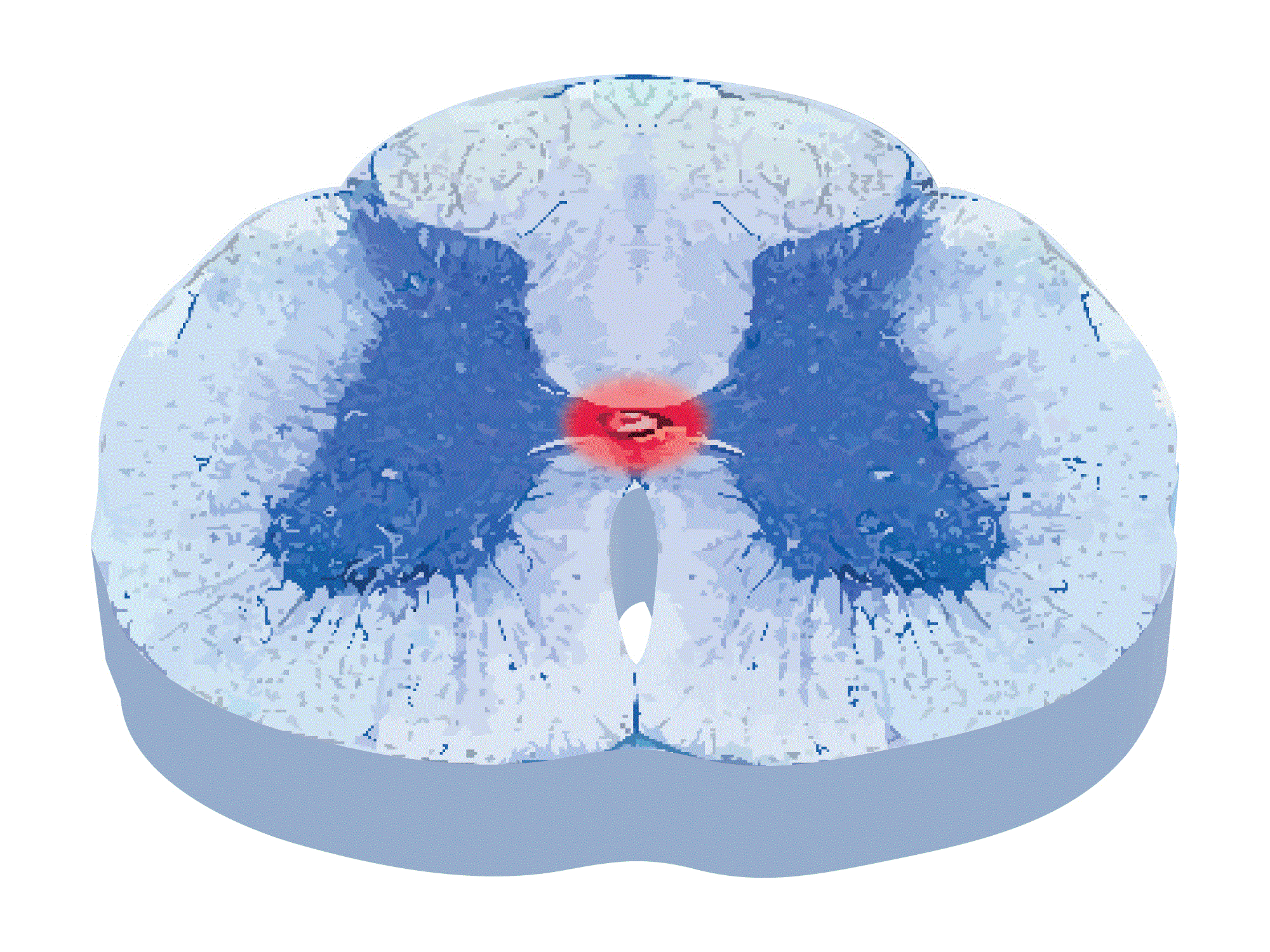 ]] ]]
|
| Answer A Explanation | [[AnswerAExp::This image illustrates a lesion in the central cord depicting syringomyelia. Poliomyelitis is not associated with lesions in the central cord.]] |
| Answer B | [[AnswerB::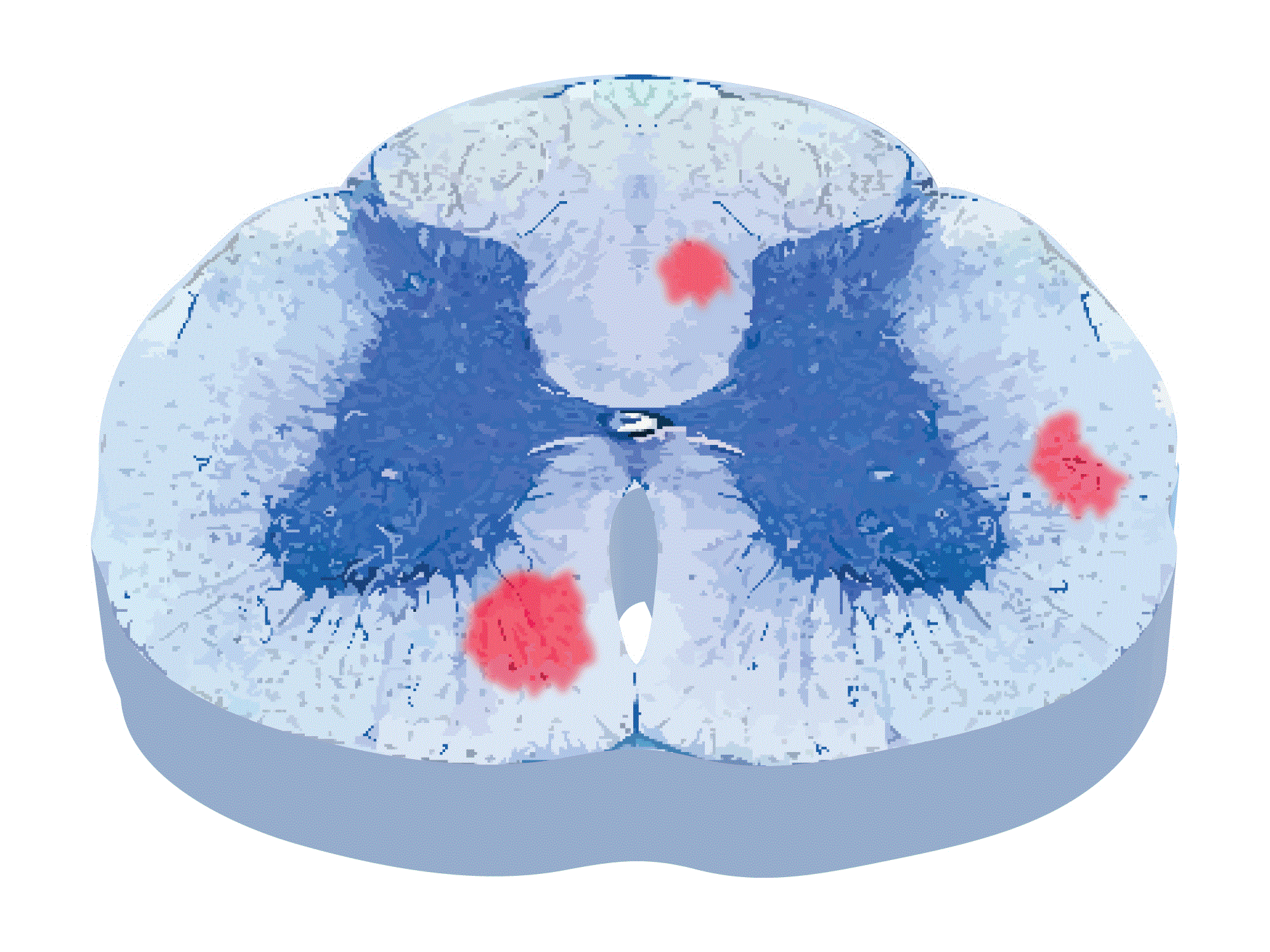 ]] ]]
|
| Answer B Explanation | [[AnswerBExp::This image illustrates asymmetric lesions in the white matter characteristic of multiple sclerosis.]] |
| Answer C | [[AnswerC::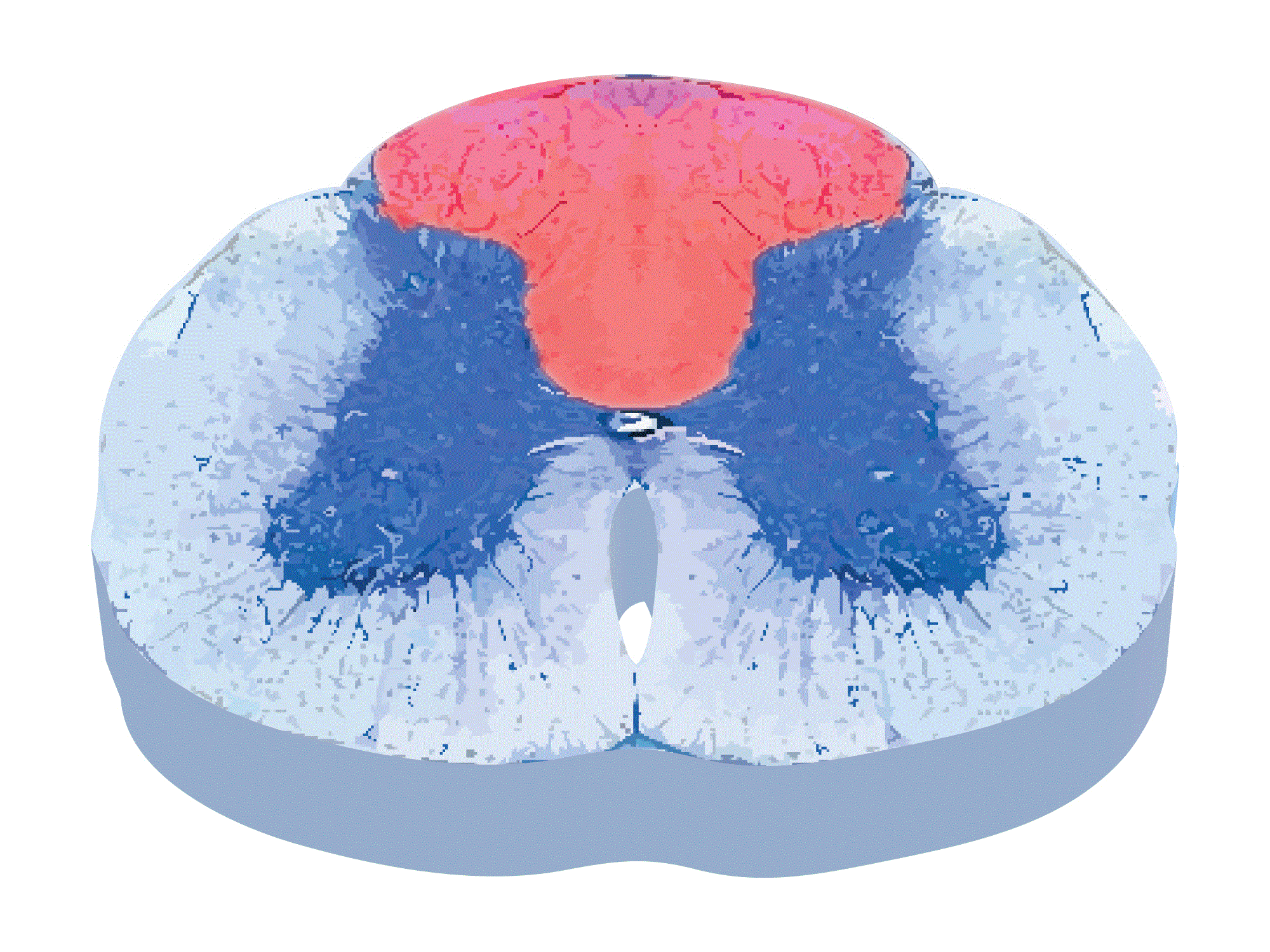 ]] ]]
|
| Answer C Explanation | AnswerCExp::This image illustrates lesions in the dorsal columns consistent with tertiary syphilis. |
| Answer D | [[AnswerD::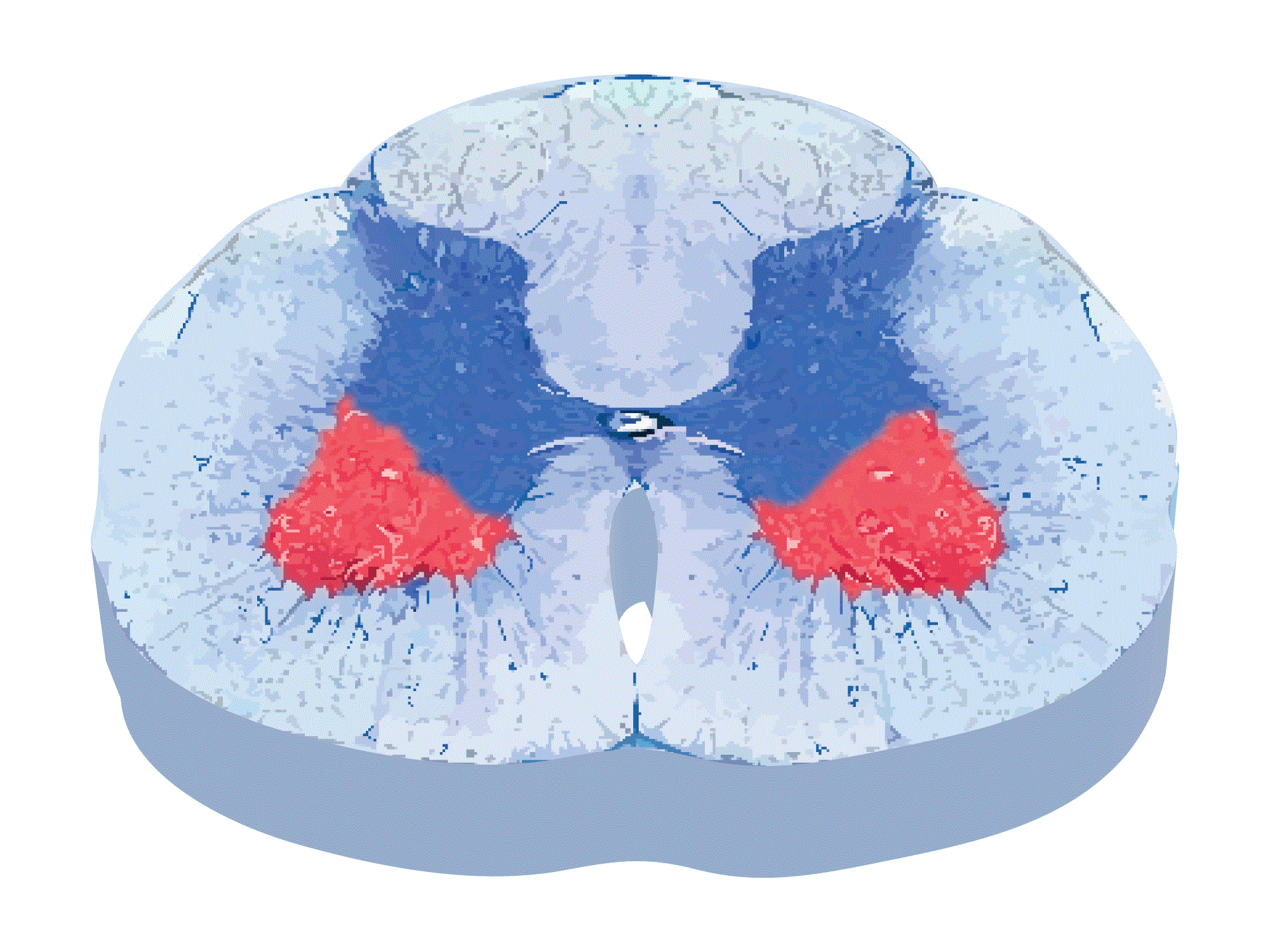 ]] ]]
|
| Answer D Explanation | [[AnswerDExp::This image illustrates lesions in the anterior horn of the spinal cord characteristic of poliomyelitis.]] |
| Answer E | [[AnswerE::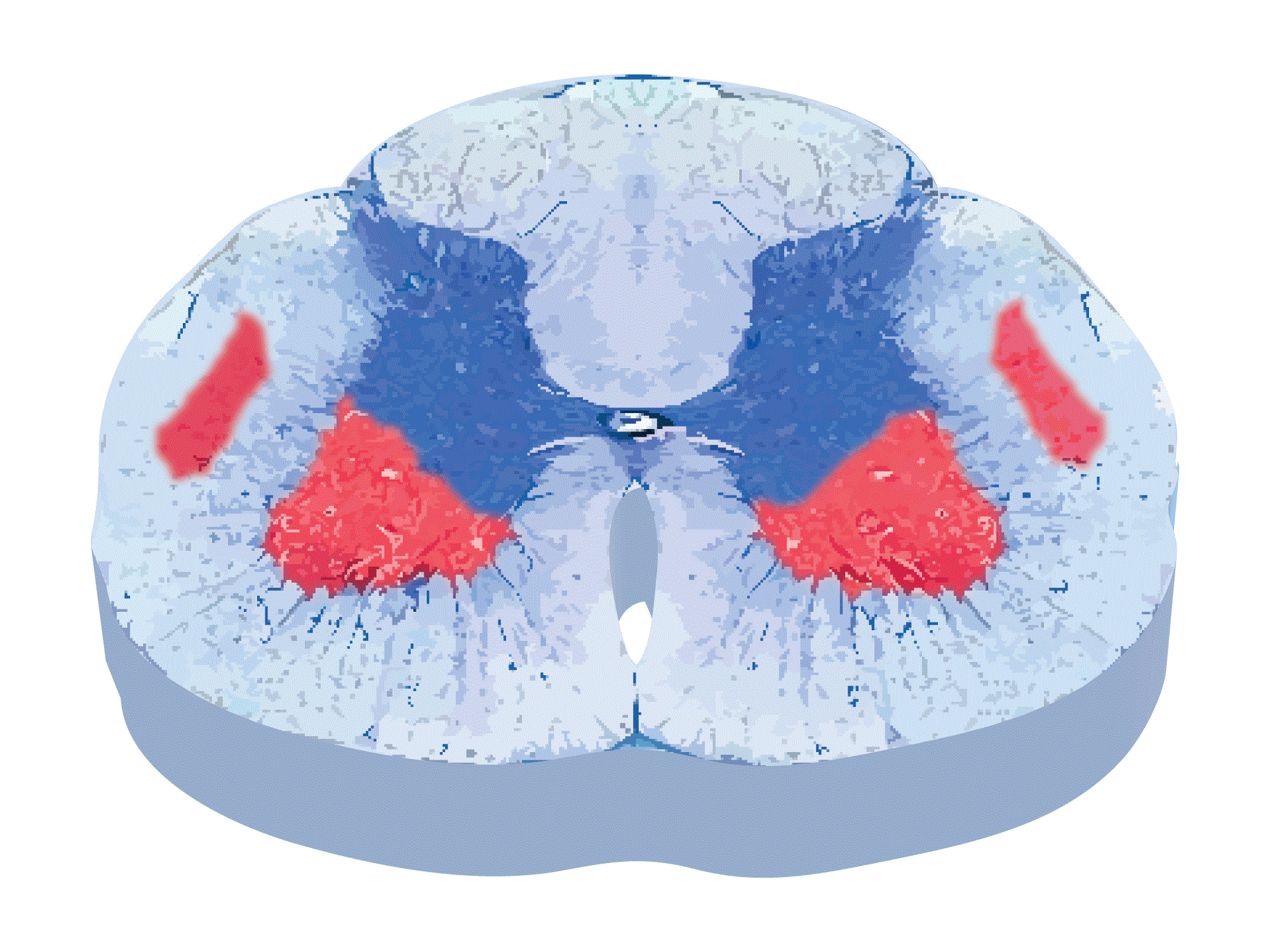 ]] ]]
|
| Answer E Explanation | [[AnswerEExp::This image illustrates lesions in the white matter and grey matter. This pattern of lesions is found in amyotrophic lateral sclerosis (ALS), which presents signs and symptoms of both upper and lower motor neuron disease.]] |
| Right Answer | RightAnswer::D |
| Explanation | [[Explanation::Poliomyelitis is caused by poliovirus, an enterovirus that peaked in the 1950s before it was almost eradicated following the introduction of the killed IPV (Salk) and the attenuated OPV (Sabin) vaccines. Poliomyelitis may result in paralytic symptoms, which may be classified as bulbar, spinal, or bulbospinal, the most common of which is the spinal paralytic poliomyelitis. Poliomyelitis may have an asymptomatic course or non-specific symptoms that may be followed by acute asymmetric flaccid paralysis of the lower extremities with areflexia within a few days of symptoms onset. Poliovirus is transmitted by the fecal-hand-oral route and replicated in the oropharynx, the intestinal mucosa, and then in the submucosal lymphatic tissue before it invades the CNS. The involvement of the spinal cord is usually at the level of the anterior horns leading to lower motor neuron symptoms.The child is presenting for acute muscle weakness following a prodrome of fever, headache, and vomiting. The findings of asymmetric flaccid paralysis, muscle fasciculation, absence of sensory involvement, and areflexia in the lower extremities are consistent with lower motor neuron (LMN) involvement that suggest poliomyelitis. Given the history, physical examination findings, and the CSF leukocytosis, the diagnosis of poliomyelitis is likely. Educational Objective: Poliomyelitis causes lesions in the anterior horn of the spinal cord. |
| Approved | Approved::Yes |
| Keyword | WBRKeyword::Spinal cord, WBRKeyword::Polio, WBRKeyword::Poliomyelitis, WBRKeyword::Enterovirus, WBRKeyword::Flaccid paralysis, WBRKeyword::Paralysis, WBRKeyword::Areflexia, WBRKeyword::Anterior, WBRKeyword::Horn, WBRKeyword::Anterior horn, WBRKeyword::Motor |
| Linked Question | Linked:: |
| Order in Linked Questions | LinkedOrder:: |